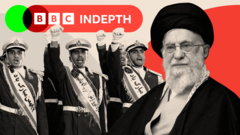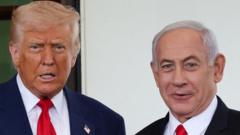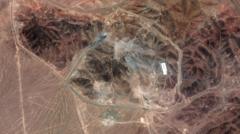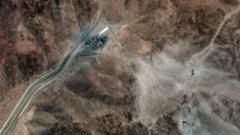With Khamenei’s re-emergence signaling potential shifts in leadership dynamics, Iran's reality is increasingly precarious as dissent grows within and beyond its borders.
Khamenei's Return: Navigating a New Iran Post-Conflict

Khamenei's Return: Navigating a New Iran Post-Conflict
As the ceasefire settles in Iran, the supreme leader faces a nation forever changed by war.
After a fraught two-week period living in a hidden bunker amid escalating conflict with Israel, Ayatollah Ali Khamenei, Iran’s supreme leader, is poised to emerge as the country grapples with the aftermath of war. The ceasefire—brokered by U.S. President Donald Trump and Qatar's Emir—may offer Khamenei a chance to reconnect with a nation in turmoil; however, his fear of assassination looms large.
During his isolation, crucial communication channels appear to have severed, isolating Khamenei from even high-ranking officials. Analysts suggest he must tread carefully upon his return to public life. Observers remain skeptical about the longevity of this ceasefire, especially as Israeli Prime Minister Benjamin Netanyahu has not ruled out further aggression.
Should Khamenei re-enter the public sphere, he will undoubtedly encounter widespread devastation and a populace weary of his leadership. While he may attempt to present a façade of triumph on state television, the realities are stark—his regime's military capabilities have been significantly eroded through the relentless bombings of key sites throughout the nation. The impact on Iran’s military infrastructure remains contested, yet the visible losses are undeniable.
Public sentiment is increasingly hostile towards Khamenei, whose longstanding pursuit of conflict with Israel and ambitions of achieving nuclear status are now under scrutiny. With the Iranian economy teetering on the brink of collapse due to extensive sanctions and ongoing warfare, many are holding him accountable for the current state of strife. Experts speculate that the fallout from this conflict could signal an eventual political shift in Iran, with Professor Lina Khatib suggesting that Khamenei could very well be the Islamic Republic's last supreme leader.
Amid this tumult, whispers of dissent have begun to permeate the upper echelons of the regime. Some former officials have reportedly been advocating for reform through Iran’s more reserved religious scholars. Heightened discontent among ordinary citizens has been palpable, with many expressing their desire for a regime change—something they fear could potentially lead to foreign intervention.
Though Khamenei’s grip on power remains, the war’s toll on the populace is significant. Acts of solidarity have surfaced among Iranians as they navigate the duality of supporting their homeland while rejecting the current leadership. However, there is a growing dread that any destabilization may pave the way for chaos rather than a constructive transition.
Domestic suppression is expected to rise as the regime clings to power. Since the onset of hostilities, authorities have executed individuals accused of espionage, and mass arrests have escalated. With fears of impending crackdowns intensifying, experts warn that the populace’s frustration may only deepen if the regime fails to deliver essential services.
Despite the setbacks in Iran’s nuclear ambitions, the country’s remaining missile capabilities pose a lingering threat, as Tehran continues to pursue secretive enrichment efforts. There exists a palpable tension in geopolitical circles, with concerns looming over Iran's potential for nuclear armament.
As Khamenei navigates his status as a beleaguered leader, speculation about his succession grows. At 86, with health issues, he faces the pressing need for an organized transfer of power, pondering whether to perpetuate the regime’s legacy or concede escalating internal pressures.
During his isolation, crucial communication channels appear to have severed, isolating Khamenei from even high-ranking officials. Analysts suggest he must tread carefully upon his return to public life. Observers remain skeptical about the longevity of this ceasefire, especially as Israeli Prime Minister Benjamin Netanyahu has not ruled out further aggression.
Should Khamenei re-enter the public sphere, he will undoubtedly encounter widespread devastation and a populace weary of his leadership. While he may attempt to present a façade of triumph on state television, the realities are stark—his regime's military capabilities have been significantly eroded through the relentless bombings of key sites throughout the nation. The impact on Iran’s military infrastructure remains contested, yet the visible losses are undeniable.
Public sentiment is increasingly hostile towards Khamenei, whose longstanding pursuit of conflict with Israel and ambitions of achieving nuclear status are now under scrutiny. With the Iranian economy teetering on the brink of collapse due to extensive sanctions and ongoing warfare, many are holding him accountable for the current state of strife. Experts speculate that the fallout from this conflict could signal an eventual political shift in Iran, with Professor Lina Khatib suggesting that Khamenei could very well be the Islamic Republic's last supreme leader.
Amid this tumult, whispers of dissent have begun to permeate the upper echelons of the regime. Some former officials have reportedly been advocating for reform through Iran’s more reserved religious scholars. Heightened discontent among ordinary citizens has been palpable, with many expressing their desire for a regime change—something they fear could potentially lead to foreign intervention.
Though Khamenei’s grip on power remains, the war’s toll on the populace is significant. Acts of solidarity have surfaced among Iranians as they navigate the duality of supporting their homeland while rejecting the current leadership. However, there is a growing dread that any destabilization may pave the way for chaos rather than a constructive transition.
Domestic suppression is expected to rise as the regime clings to power. Since the onset of hostilities, authorities have executed individuals accused of espionage, and mass arrests have escalated. With fears of impending crackdowns intensifying, experts warn that the populace’s frustration may only deepen if the regime fails to deliver essential services.
Despite the setbacks in Iran’s nuclear ambitions, the country’s remaining missile capabilities pose a lingering threat, as Tehran continues to pursue secretive enrichment efforts. There exists a palpable tension in geopolitical circles, with concerns looming over Iran's potential for nuclear armament.
As Khamenei navigates his status as a beleaguered leader, speculation about his succession grows. At 86, with health issues, he faces the pressing need for an organized transfer of power, pondering whether to perpetuate the regime’s legacy or concede escalating internal pressures.





















